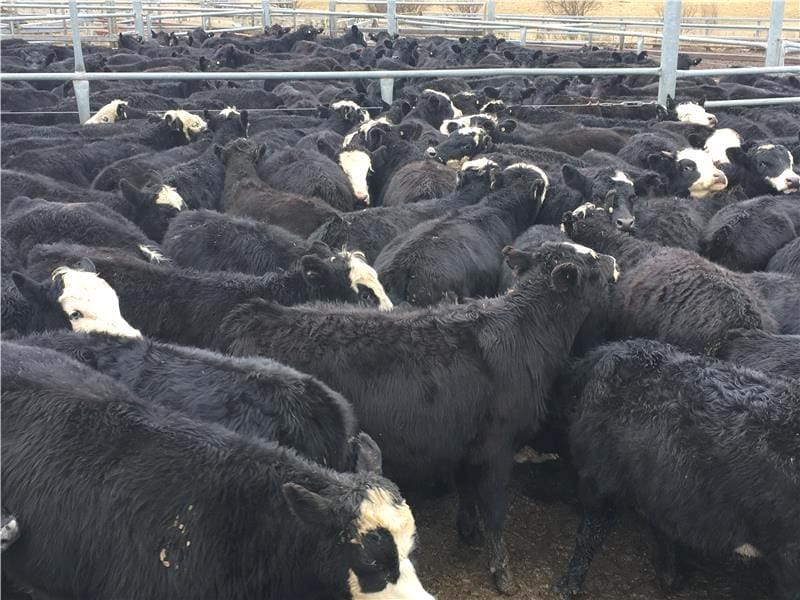
Black baldie steers
In response to a recent reader inquiry (see reference at base of page) regarding the degree of heterosis he could expect in his breeding program, we thought it was timely to prepare a ‘Crossbreeding 101 refresher’. This two-part series starts this week with a look at the contributing effects that create heterosis (hybrid vigour), and will continue next week looking at managing heterosis in practice…..
IT would be fair to say that crossbreeding is a topic that most beef producers have considered at some point in their business.
The effectiveness of crossbreeding programs is always a source of discussion among producers either at field days, industry workshops and even in comments by readers to Beef Central in response to articles.
Often, these discussions focus on the practicalities of commencing and managing certain crossbreeding strategies. While these are valuable discussion points, they often overlook some of the fundamentals that underpin why crossbreeding can be a valuable approach for beef producers.
If a producer were to be asked why he or she might consider a crossbreeding program, the most common response would be “in order to capture hybrid vigour and increase production.”
Essentially this is the primary reason for crossbreeding. At the same time, however, many producers don’t always understand how heterosis (or hybrid vigour) occurs, and as result progress into crossbreeding systems gradually start to deliver more disappointing results in their herds.
The basics of heterosis
It is worth looking at the basics of heterosis and using this understanding as part of a well-designed crossbreeding systems. Heterosis is expressed in crossbred animals because of an increase in genetic diversity from two separate breeds and from genetic interactions. It is seen as improved production or performance in crossbred animals when compared to the average of their parent breeds.
There are a few genetic reasons for these improvements. One is known as the dominance effect. Dominance is the term used as a description when an allele of a gene masks or supresses the expression of an allele. In a F1 calf (the result of two different breeds), if that calf possesses a dominant and a recessive gene, the trait associated with the dominant allele will be the trait expressed.
The most common example is breeding for polledness. The allele for polledness is often described using capital P. When an animal possesses two alleles, PP, the animal will be polled. However, if that animal was an F1 and one parent was a polled PP animal and the other a Horned (pp, sometimes referred to as HH to try to avoid confusion), the F1 calf would carry one copy of each allele. This F1 animal would be Pp. Because polledness is the dominant trait, the F1 calf will be polled.
Many people rely on the dominance effect to achieve production outcomes such as breeding for polledness. As an effect it is not only a result of heterosis, as many producers select for specific traits within breeds. So, while dominance is one contributor to improved production, it is not the only contributor to the overall improvements achieved in crossbreeding.
Overdominance
A second effect is known as Overdominance. A heterozygous (crossbred animal) will carry two different alleles, which will interact with each other resulting in a superior outcome than can be expected from animals that have two copies of the same allele. The advantage seen in the crossbred animal is the result of the combination of different alleles.
Epistasis
The third effect that also occurs are the genetic interactions known as Epistasis. Epistasis describes both the interaction that different genes have with each other, and on the combined effect of adding both parents’ genes. Known as the non-additive effects, the combined effect of genes may be different to making a straight comparison by adding up the effects of the parents’ genes. This is due to the dominance or overdominance of individual genes.
At a genetic level these effects are occurring in every mating. However, heterosis capitalises on these effects, particularly when genetically different breeds are used in the program. The use of two different breeds results in a greater diversity of genetic combinations through epistasis. And there is likely to be less occurrence of recessive traits that could lower production because of genetic dominance. More closely related breeds (ie Angus x Hereford) are likely to have less diversity than diverse breeds (Angus x Brahman), resulting in lower levels of heterosis.
Why commence crossbreeding?
To go back to the question of “why commence crossbreeding?”, it really is to create a system where genetic diversity can be achieved, and so capture the benefits of these interactions at a genetic level. While this might be a good reason, perhaps a better question is why does heterosis matter?
Heterosis matters in production systems because the traits it benefits to the greatest degree tend to be less heritable and as a result are more sensitive to the environment.
Production traits are described by heritability, which is the percentage of variation that is a result of genetics rather than the environment.
Traits of high heritability are generally easy to select for, and this is the case with production traits such as growth or IMF% (marbling). Low heritability describes traits which are more impacted by the environment, such as fertility. The combination of genes in crossbred animals results in higher levels of heterosis, meaning that producers are more likely to achieve better production outcomes in these traits.
It is also worth noting that the benefits from heterosis are not fixed in place so that crossbred cattle always outperform straightbreds. Where environmental conditions, particularly nutrition, are not limiting, there may be very little difference in production metrics between straightbred and crossbred cattle. This can be particularly true if the breeds used in the crossbreeding program are genetically very similar or were only genetically average for their breeds.
However, in more challenging environments or variable environments, the genetic diversity obtained from heterosis is most likely to see those cattle performance better and achieve higher levels of production.
This performance is not restricted solely to production traits. The ability to adapt and cope with higher environmental stresses can result in more adaptable and productive breeding herds, which is often noted in traits such as breeder longevity.
Published below here is the reader comment on an earlier genetics article inquiring about the use of F1 bulls:
“I have been using Herefords on Black Angus cattle to raise the F1 cows and then I put a mixture of Herefords and Angus bulls with the F1 cows. I was getting calves that were too much Hereford or too much Angus. I bought purebred horned Hereford cows and then AI’d then to Angus bulls and kept the best bulls for myself. I am looking to find out how much heterosis I maintain by running F1 on F1?”
 Alastair Rayner is the General Manager of Extension & Operations with Cibo Labs and Principal of RaynerAg. Alastair has over 28 years’ experience advising beef producers & graziers across Australia. He can be contacted here or through his website www.raynerag.com.au
Alastair Rayner is the General Manager of Extension & Operations with Cibo Labs and Principal of RaynerAg. Alastair has over 28 years’ experience advising beef producers & graziers across Australia. He can be contacted here or through his website www.raynerag.com.au
